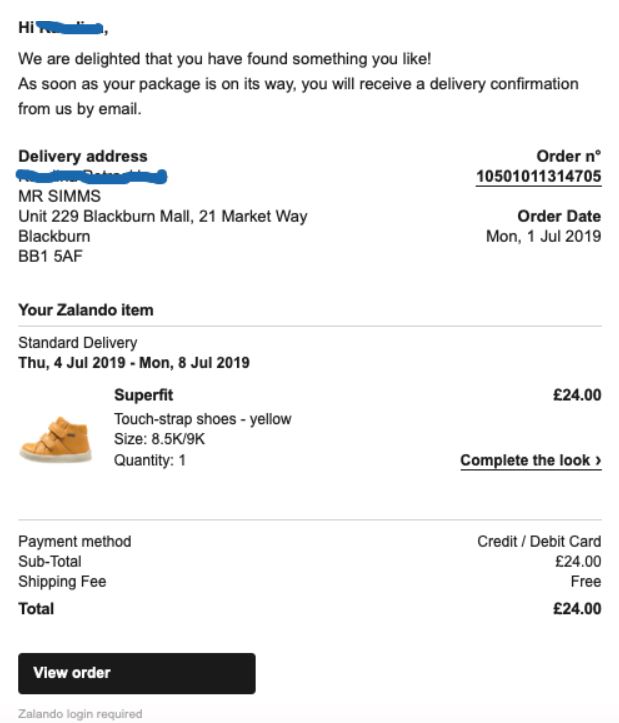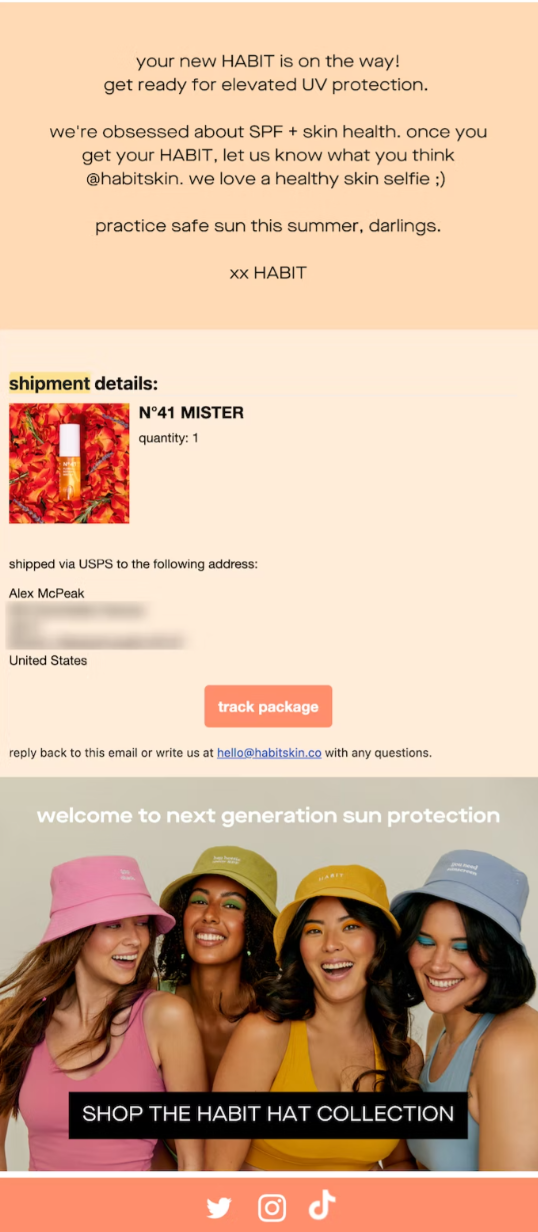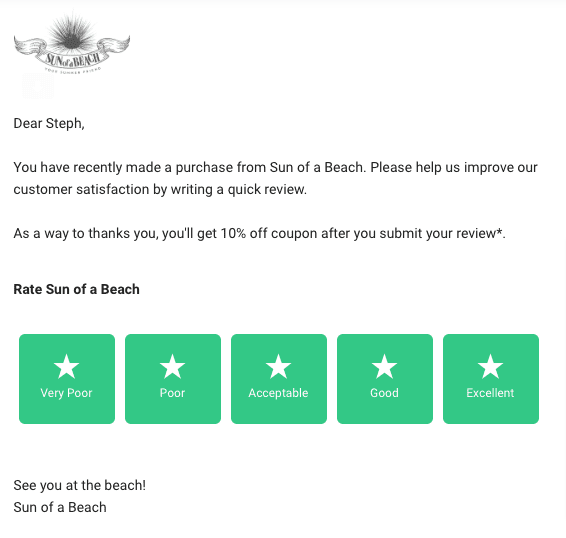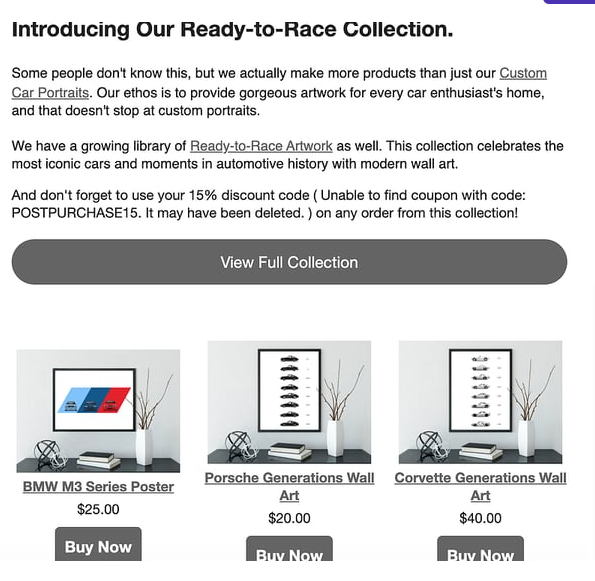
Do you know the average probability of converting a first-time prospect is around 1%? But don’t let that discourage you! Instead, focus on leveraging your existing customer base. By using post-purchase emails as a part of your email marketing strategies, you can convert your existing prospects without resorting to hard-selling tactics.
Take a quick look at the post-purchase email campaign flow below:
- Express gratitude and provide an order confirmation. Show your appreciation for their purchase, and assure them that their order is confirmed.
- Send a shipping confirmation. Inform customers about progress, and excite them about the upcoming delivery.
- Educate about the product. Share tips, instructions, or suggestions on how to make the most of the product.
- Request a review or feedback. Encourage customers to share experiences, reviews, and feedback.
- Present cross-selling and upselling opportunities. Suggest complementary products or upgrades.
This flow of post-purchase emails will get you repeat customers. Remember, it’s all about building relationships and offering value every step of the way. Keep reading to learn the craft.
1. Thank you and order confirmation email
Showing appreciation towards your customers for their purchases is an excellent way to build relationships and maintain their loyalty. That’s why sending a thank-you email is the best way to start your post-purchase email marketing campaign. But if you have concerns about flooding your customer’s inbox, you can combine them with an order confirmation email.
According to research published on Shopify, the open rate of an order confirmation email is between 70-90%, which is significantly higher than the average of 20% for a typical email campaign.

This way, you can show your appreciation, and at the same time, your customers get a confirmation of their order without any extra clutter in their inboxes. You can manage these emails by using email marketing software.
Best post-purchase email campaign practices:
- Use efficiently conveying subject lines for the email like:
- “Thank you for your order!”
- “Your subscription is confirmed!”
- “Thank you for your payment!”
- Craft the copy to be more customer-specific.
E.g., To express gratitude to your first-time buyers, a product-specific thank you email can be effective. But, if a customer has made multiple purchases, sending a ‘thank you for your support’ email will be more appropriate.
- Include the order details like order summary, shipping address, customer contact details, order number, cost breakdown, shipping method, estimated delivery date, product banners, and customer support details.
- Send the order confirmation email soon after the customer makes the purchase.
- Make sure you provide an opportunity to engage with your brand by giving any one specific CTAs like:
- Follow on social media.
- Join a loyalty program.
- Become a subscriber
- Contact customer support.
2. Shipping confirmation email
The shipping confirmation email, which comes under the transactional email category, addresses the customer’s concern about their order updates. If you are not carefully crafting your shipping confirmation email, the chances of your customers looking at them like marketing or selling one are delicate. But it is also important for email marketing freelancers not to miss the chance of marketing using transactional emails, which has a potentially high open rate. So take advantage of the 80/20 rule.

This will help you maintain 80% of your shipping confirmation email with transactional content and 20% with marketing content. (Note: If you’re working with a banner design agency or a graphics design agency, ask for an unlimited design service plan. This lets you experiment with custom-built email templates rather than standard templates, which customers immediately recognize as junk marketing emails).
Best post-purchase email campaign practices:
- Add a product tracking link.
- Include purchase details like order and delivery date, delivery address, payment details, and shipping method.
- Include the resources for customer support.
- Cross-sell by suggesting related items that support the customer’s previous purchase.
3. Product education email
Product education emails like how to use the product, how to care for it, or how to assemble it are essential for creating loyal relationships with customers. It is another way of showing that you really value your customer’s user experience.

It will not only increase repeat purchases but also reduces the probability of returning their new product.
Best post-purchase email campaign practices:
- Leverage visual communication. Use visual aids like product images or upload product videos to educate customers about using the product to obtain maximum benefit.
- Make the email more personal and relevant by addressing the customer by name and mentioning their purchase.
- If there are multiple products, use segmentation to provide instructions particular to the items in their corresponding order.
4. Review or feedback email
If you don’t ask for a review, customers tend to leave a review only when they have a bad user experience with the product. That’s why feedbacks and reviews are unavoidable in every purchase, especially with customers you are confident of having a positive user experience.

Also, gathering feedback directly from your customers is a fantastic way to gain insight into your product. And, if you use user-generated content like reviews, it can help other shoppers when browsing your site and deciding to make a purchase.
Best post-purchase email campaign practices:
- Send your review or feedback email at the right time – not too soon after the purchase (to allow for delivery and product usage), but not too late (to ensure the experience is still fresh in the customer’s mind).
- Before asking people to leave feedback on a public platform, try getting them to share their thoughts with you first.
- Make it easy for the customers to leave feedback by giving a clear CTA button.
5. Cross-selling and upselling email
Cross-selling is nothing but marketing products that are relevant to the customer’s previous purchase. At the same time, upselling is encouraging the customer to purchase a higher-end product or additional features that will elevate their primary product experience.

The benefit of cross-selling and upselling in the post-purchase email campaign is that you are not hard selling people the products they don’t care about. Therefore the chances of converting are higher.
Best post-purchase email campaign practices:
- Make sure you pick the right services or products for upselling or cross-selling.
- Provide a coupon code or discount offers along with the upselling and cross-selling products.
- Use urgency-inducing words like “Hurry,” “Limited-time offer,” or “Sale ends today” while writing the copy to create a sense of urgency.
- Showcase three products in the upselling or cross-selling category by taking advantage of the ‘Power of Three’ marketing principle.
Conclusion
If you want to sum up the post-purchase email campaign flow that will boost customer engagement and drive repeat sales, here is the list of emails you have to create:
- The thank you and order confirmation email
- Shipping confirmation email
- Product education email
- Review or feedback email
- Cross-selling and upselling email
Sales and marketing teams also play a critical role in creating effective post-purchase email campaigns that drive repeat sales and increase customer engagement. By leveraging the customer data collected during the purchase process, sales and marketing teams can personalize the email content to reflect the customer’s specific interests and preferences.